Web Exclusive Essay
A Global History of Secondhand Clothing
Clothing, almost by definition, is a medium of transmission within a spreadable media ecology. It is both the means and the site for the storage and spread of information. Clothes are made to be carried by the human body (as in the French porter and the Haitian Creole pote). Textile skins were, from their origins, portable artifacts and temporary prostheses, shaped by the demands of a mobile body and inscribed with markers of that body’s history. The demands on clothing have always been high—armor (protection against shame, enemies, and the elements) and aesthetics, comfort and durability. Clothing is portable, proximate to the human body, and eminently changeable. Clothes remain artifacts in continual flux. They convey messages to the world, and they also provide the raw material for subversion of precisely these messages.
Before the industrial era, vestments were few and far between. Their production took a great amount of human and material resources. Into their tailored forms much was literally and culturally invested. In the Western tradition, throughout the Middle Ages and Renaissance, clothing—once shaped to a given body—might be worn for years, sometimes carried for a lifetime. The clothing wore its owner as much as the owner wore the clothing, bearing comparable markers of a personal narrative. Through the movements of a body in time, its clothes would acquire increasingly personal and human characteristics—worn knees and elbows, a stretched waist. Stains, patches, tears, and color changes accompanied a life journey, or at least several decades thereof.
Sometimes an article’s function was portable. This was especially true when even the simplest clothing was scarce: its production costly, time consuming, and labor intensive. A coat might be cut down into a vest, or a dress into a scarf. As a garment’s function evolved, so too might the identity of its wearer. A dress might be handed from mother to daughter through a gift economy. In such instances, it carried with it signs and markers of generational passing. A master might give his worn-out shirt to his servant, for whom it could serve as either bodily cover or portable currency. In the Renaissance, it was common for servants to sell their masters’ old clothing to peasants in neighboring villages. Itinerant rag and old clothes dealing grew into a veritable calling within a commodity-based economy. This was a profession of portability. The dealer became an intermediary between wearers, marking a transitional phase in an article’s mobile life history.
The advent of mass reproduction heralded an era of increasing clothing production, in western Europe and North America especially. The more clothes there were, the more they changed hands, spreading out geographically. Cotton gins, mechanical looms, and sewing machines made clothing easier to produce and more affordable to populations. By the mid-nineteenth century, prêt-a-porter (ready-to-wear, ready-to-carry) clothing was being produced, traded, and consumed in the international market economy. With more clothes for the taking, the middle class purchased more of them, therefore wearing each garment for less and less time.
Fashions changed faster. Clothing, manufactured by a mechanized migrant and immigrant labor force in the United Kingdom and the United States, became increasingly inexpensive to produce. Clothes became common instead of rare, and worn clothes were discarded or exchanged at an ever quicker pace. The paths of clothing increasingly departed from the bodies of single individuals and their families and began to travel the world. The result of excess was a new genre of, and set of possibilities for, salvaged clothing as a medium of grassroots circulation, transformation, and exchange.
A range of paths developed for the second (and third and fourth) lives for secondhand clothing by the nineteenth century. A “shoddy” industry developed in England and North America, alongside the textile mills of the old and new Englands. Shoddy originally referred to a durable fabric woven out of a yarn spun of shredded refuse woolens. Shoddy, which stuffed the interiors of horse-drawn carriages, was refashioned into the wool uniforms and blankets that American and British soldiers carried on their bodies and wrapped around their fears in World War I.
By the early twentieth century, secondhand clothing was resold in shops and through itinerant merchants. Many, and often most, of the junk and rag dealers operating in American, Canadian, and western European contexts were enterprising Jewish and Italian immigrants. In New York City, for example, ragmen collected castoffs from uptown and carried them downtown for purchase by recent arrivals in need of inexpensive clothing. A new set of bodies, and a new set of histories, carried the old clothes into new places and directions. A wool suit jacket tailored on the Upper West Side traveled on the back of a wealthy banker between Central Park and Park Avenue. Stained at a champagne toast and discarded after six months, the suit jacket navigated a new existence in the thicket of the Lower East Side. Picked out of a rag dealer’s wheelbarrow, minus several buttons, it was purchased by an Orchard Street milkman who wore it on a daily delivery route winding through Chinatown. The jacket took the shape of its wearer and carried his weight. Traces of the Jewish community—the smells of eastern European cooking and cast-off buttons hawked by a peddler—were inscribed deep into the warp and woof of the woolen fabric. The satin interior, a second skin lining a second life, carried the increasingly sweat-stained labels naming its original owner and the uptown tailor. Every wearing in is also a wearing out.
Textile media—both the material out of which new entities are produced and also the means by which information is encoded and information transmitted—spread across the globe. Clothing’s portability grants it a history of embodiment and transmutation, moving among bodies, cultures, nations, and economies. It carries traces of one across the boundaries of another. In the late twentieth and twenty-first centuries, cast-off clothes from North America and Europe increasingly journey overseas en route to encounters with new wearers. Clothes are compressed into half-ton bricks, bales that might contain shirts off hundreds of human backs. A Panamanian ship, manned by a Romanian crew, carries the discarded textile skins to the port of Port-au-Prince. What arrives in Haiti, called pèpè, is a resource to be worn and carried (pote in Haitian Creole), an identity to be had, and a politics on which to reflect. Pèpè is a portable currency whose materiality is transformed by multiple processes of alteration, exchange, and wear. Clothing wears the traces, and bears the burdens, of a global media history in progress.
On the Figures
Photographs document secondhand clothing’s role in today’s world of spreadable media, as media of communication and subversion of hegemonic styles and economic pathways. Vanessa Bertozzi and Hanna Rose Shell made these images in Haiti, during the summer of 2006, as part of a collaborative ethnographic project that culminated in their experimental media essay Secondhand (Pepe) (2007, distributed by Third World Newsreel).
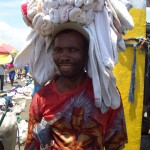
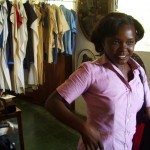
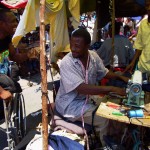
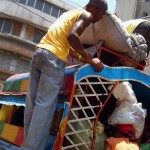

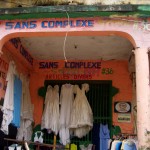
Leave a Reply